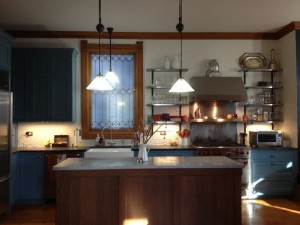Lincrusta is a heavily embossed wallcovering, which was launched in England in 1877. It was invented by Frederick Walton, also the inventor of Linoleum. Since that time, Lincrusta has found its way into some of the finer homes all over the world. Today, it is often used in historical restoration projects, or to add a “period” charm to vintage homes. It is intended to be painted and can be glazed to further highlight Lincrusta’s beautiful designs.
Our house painting company was recently hired to install and decorate four different Lincrusta wallcoverings, as part of a much larger staining, painting and decorating project in Chicago. The owners were converting a one-hundred-year-old two-flat to a single family home. They had also built a substantial addition to the rear of the house and made sure all the materials used and the work done in their house was respectful of the “period” of their house. After noticing those concerns, when they were still at the stage of deciding on whom to hire for their house painting project, I thought of asking them if I could send them a link that I thought might be of interest to them – it was a link to the Lincrusta! After checking out the link, they fell in love with the Lincrusta designs. We not only got their entire painting and decorating project, but we were also commissioned to install and decorate four Lincrusta wallcoverings.
This two-flat was originally designed for the owner to occupy the second level of the house – it was therefore more upscale. After deciding to hire us and selecting those Lincrusta papers, they had me take a look at the front staircase leading to the second level of the house, which I had not been shown to me until then. There it was: a Lincrusta imitation from the late 1910’s below the chair rail! No wonder the clients bonded with the idea of having Lincrusta wallcoverings in other parts of their house!
Listening deeply for the needs and concerns of our clients and coming up with decorating ideas that meet those needs is what we are about as a house painting company.











 Follow
Follow












